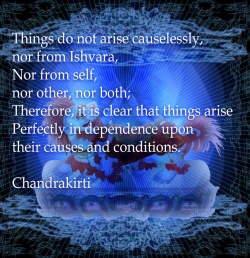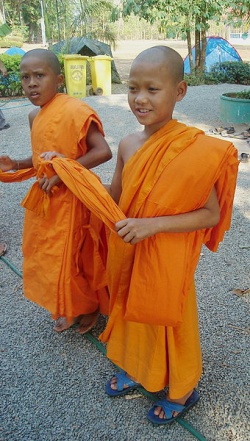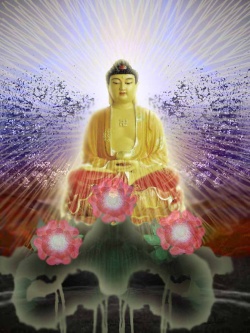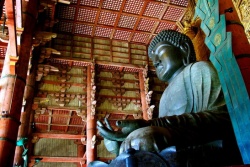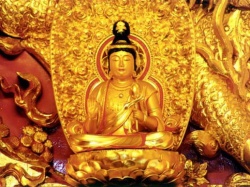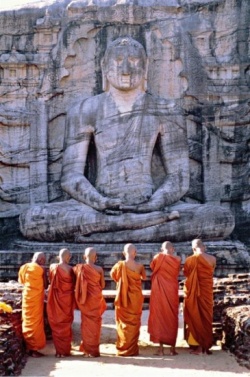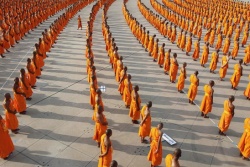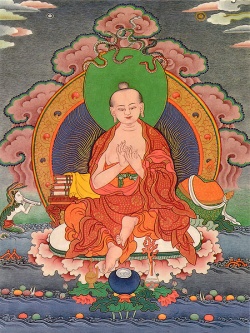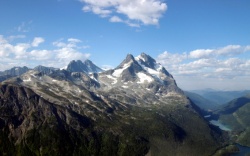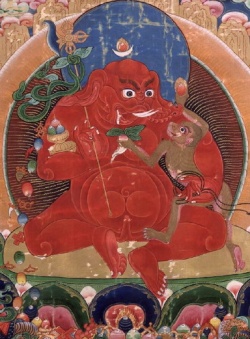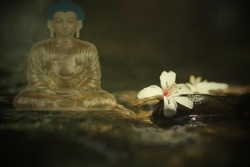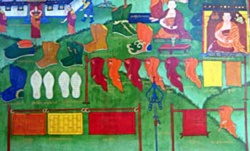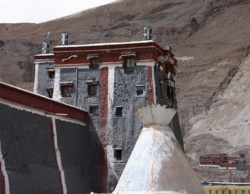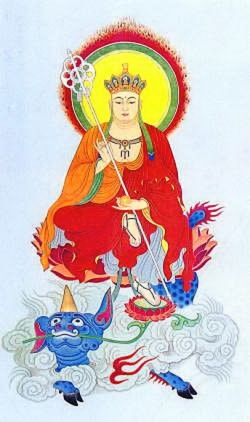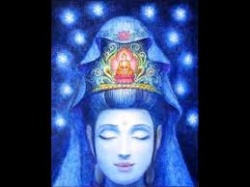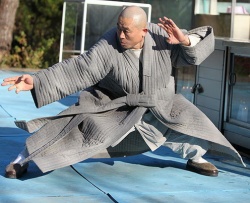The Laghutantraṭīkā by Vajrapāṇi: A Critical Edition of the Sanskrit Text
The Laghutantraṭīkā by Vajrapāṇi: A Critical Edition of the Sanskrit Text
PREFACE
The Laghutantratìkà by Bodhisattva Vajrapani is a work that belongs to the tantric phase of Indian Buddhism. Its main peculiarity is that it adheres to the doctrines o f two tantric cycles, the Cakrasamvara and the Kàlacakra.
Indeed, it is a commentary on the fir s t chapter of the Cakrasamvaratantra, the basic text of the homonymic tradition that is little known in the West:
the present work is the first edition of a commentary on the Cakrasamvaratantra.
At the same time, however, the Laghutantratìkà is also one of the most important texts of the Kàlacakra, the last tantric chool that developed in India.
The Sekoddesa, the Vimalaprabhà, the Hevajratantrapindàrlhatìkà and Vajrapàni’s work are the first texts of this tantric tradition.
Vajrapàni’s work is notable both for its content and its historical aspects: although some themes dealt with in the Laghutantratìkà also appear in the Vimalaprabhà, where they are discussed in depth, other arguments, above all the sadahgayoga, are examined in fu ll fo r the first time in the Kàlacakra literature by Vajrapàni.
As fa r as historical importance is concerned, it suffices to remember that the Laghutantratìkà appears to be the most ancient Kàlacakra text, preceded only by the Adibuddhatantra o f which only fragments sun>ives, the longest being the Sekoddesa.
The publication o f the Sanskrit text o f the Laghutantratìkà is part o f a research project under the auspices o f the Italian CNR (Centro Nazionale delle Ricerche): this project was started in 1991 and is directed by Professor Raniero Gnoli.
The original manuscripts used fo r this edition are preserved both in the National Archives o f Kathmandu and in the IsIAO (formerly known as the IsMEO) Library o f Rome where a modern Nepalese manuscript and the photos o f another manuscript, obtained by Professor Giuseppe Tucci in Tibet, are preserved. These photographs are probably the only surviving testimonies o f above-mentioned manuscript.
First o f all, I would like to express my gratitude to the late Professor Giuseppe Tucci.
Thanks to him and his foresight. I was able to fin d in Rome two manuscripts o f a work whose the importance he realised more than sixty years ago. For me these manuscripts represent the strong bond between teacher and pupil, although thev are little consolation for not having known him personally.
I am grateful to Professor Gherardo Gnoli, President o f the IsIAO and to its Board o f Directors, fo r having accepted this work fo r publication in the Serie Orientale Roma. I wish to thank Professor Vraj Vallabh Dwivedi, a great scholar and kind host, who in Varanasi gave me explanations concerning the literature o f the Cakrasamvara tantra, and from whom / received copies o f two manuscripts o f the Cakrasamvaratantra and a transcription o f the stanzas o f the first chapter.
I would also like to thank Professor Michael Hahn - who was so kind as to analyse the manuscripts o f the Laghutantratika and to give me useful information on their characters - and Professor David Seyfort Ruegg who made suggestions that helped me to understand the chapter devoted to nitartha and neyartha.
I am deeply indebted to Professor Raffaele Torella, and have always set great store by his guidance and valuable advice. Professor Raniero Gnoli showed me the manuscripts o f the Laghutantratlka brought to Rqme by Giuseppe Tucci and suggested I continue to work on this project after my degree thesis: he has given me encouragement and help in eveiy phase o f the work.
I am dedicating this work to Raniero Gnoli, who has given me - with the patience o f the educator - the possibility to draw on the rare knowledge that animates his vast doctrine on Indian thought. Lastly, I would like to thank Antonio Fiaschetti and Susan Ann White fo r their help in revising the English text.
The Mulakalacakratanlra and the First Works o f Kàlacakra The Kalacakra tantric cycle was conceived in North-West India around the X-XI century.
It is still problematic to place in a definite historical and chronological context the protagonists, events, and works o f the Kalacakra tantric school because o f the continuous interplay between history and myth.
Much has been written regarding the chronology o f Kalacakratantra teachings and many scholars have expressed themselves on this them e1.
Here it suffices to summarise the salient points o f the historical and mythological aspects o f Kalacakra tantra, in order to show Vajrapani’s work in relation to these, and the great importance assumed by the text in the first phase of the spreading o f the ‘Wheel o f Tim e’ tantra.
The philosophical conceptions and mystical aspirations o f the last great Buddhist school in India were initially confined to various texts that could be considered as the fundamental works o f Kalacakratantra.
These texts are the Mùlakàlacakratantra or Adibuddhatantra (also called the Paramadi-buddhatantra), which is considered the basic (mula) Kalacakra text;
the Laghukalacakratantra, a summary o f the Adihuddhatantra, composed by Sriyasas; and, lastly, three works known collectively as the ‘Bodhisattva corpus the Vimalaprabhà by Pundarika, a detailed commentary on the stanzas o f the Laghukàlacakratantra; the Laghutantratìkà by Vajrapani, which is - as will be seen later - a commentary on the first ten and a half stanzas o f the Cakrasamvaratantra’, and the Hevajratantrapindàrthatìkà2 by Vajragarbha, a gloss on the first 120 stanzas o f the Hevajratantra. 1
See Gnoli-Orofino 1994: 59-68; Newman 1987b, 1998b; Orofino 1994b: 11-24; Grònbold 1991. 2
The critical edition and the English translation o f this work are about to be published by F. Sferra. Here we shall refer to a provisional transcript that Sferra has kindly allowed us to consult.
According to tradition, the Àdibuddhatantra was revealed to Sucandra, the king o f Sambhala, by Buddha himself, in Dhànyakataka, near Amaravati.
Sucandra returned to Sambhala, situated in a valley surrounded by high, impenetrable mountains, where he transcribed the Àdibuddha-tantra and compiled a detailed commentary on it.
In virtue of this work, the sovereign preserved and handed down the teachings o f the Kalacakra school.
Sucandra was succeeded by six priest-kings who reigned for six hundred years (one hundred years each), protecting the kingdom and spreading Buddhist Law.
Like the root {mula) texts of many other tantras, the Adibuddhatantra has not reached us either in Sanskrit or in the Tibetan translation3. Only the section devoted to initiation {sekoddesa) arrived in India and then in Tibet:
the First Dalai Lama, rGyal ba dGe ’dun grub pa (1391-1474/5)4, and, more recently, the Thirteenth Dalai Lama, rGyal ba thub bstan brgya mtsho (1876-1933)5, have affirmed that the entire Àdibuddhatantra did not leave Sambhala.
As regards the Àdibuddhatantra, only a certain numbers o f stanzas are quoted in later Kalacakra works, to which we have to add the long fragment from fthe fifth chapter, the Sekoddesa, which was been completely translated into Tibetan and whose original Sanskrit text has now been restored by Raniero Gnoli6.
Also in the Laghutantratika we find several stanzas from the Àdibuddhatantra, some o f which belong to the Sekoddesa and are grouped in the second half of Vajrapani’s work.
To these stanzas we should add a verse that Vajrapàni does not attribute to the Kalacakra basic text and which Pundarlka, in the Vimalaprabhd, quotes as a sloka belonging to the Àdibuddhatantra1. We are inclined to 1 3 See Newman 1987a: 98. The Tibetan scholars do not seem to dwell on this problem and, generally, they accept without reservation the existence o f a maialatura although it has never been translated into Tibetan.
They believe that the teachings and doctrines o f any tantric school derive from the first summarized text (laghutantra, abridged tantra), which usually derives, in its turn, from a basic text (nndatantra). Regarding the turila text o f the Cakrasamvara, see Tsuda 1974: 27-45. 4
See Mullin 1991: 233 (translation o f dPal-dus-kyi 'khor-lo-rim-gnyis-kyi-zin-bris by rGyal ba dGe 'dun grub pa). 5
See Mullin 1991: 129-130, 2 1 1 (translation oidP al-dus ’klior-dor-bsdus-bstan-pa by rGyal ba thub bstan brgya mtsho). 6
Regarding the edition o f the Tibetan text and the restoration o f the Sanskrit text by Gnoli, see Orofino 1994: pp. 127-151.
Vajrapani, in the conclusive part o f his work, also affirm s that the Sekoddesa is a chapter o f the Àdibuddhatantra (see p. 115) and he mentions another section o f the /mila text devoted to the samayas {samayapariccheda). 7 y o grid iiiatliikdbhoktii sevako IShgalJ vanik saddhantiavikrayi niCtrkho na cakre ganattàyakah.
'think that in the period during which the Laghutantratika was compiled (probably at the end o f the X century), the (ext o f the Àdibucldhatantra did not appear in the form that it would assume when the Vimalaprabhà was composed, shortly afterwards.
We do not know if the Adibuddhatantra ever existed in a complete form: the text seems to have originally consisted of ancient nuclei, like the Sekoddesa, which were acknowledged and quoted by various yogins, who subsequently decided to adhere and contribute to the doctrines that were expressed in those nuclei elaborating other sections o f the text8.
Suresana, the last priest-king, and Visvamàtà, his queen, had a son called Sriyasas ; he was the first in the line o f twenty-five kalkin kings and, above all, the author o f the Laghukàlacakratantra, the abridged version of the Adibuddhatantra.
The Laghukalacakratantra is a complex work due to the great variety o f its subject-matter and the fact that the stanzas are written according to the strict metre o f the sragdharà, which makes the meaning o f the text rather cryptic.
The son o f Sriyasas, the Bodhisattva Pundarika, composed a detailed commentary on his father’s work and called (t Vimalaprabhà.
This text is, without doubt, the only complete means o f understanding the philosophical and mystical concepts o f the Laghukalacakratantra and o f the whole Kalacakra cycle.
The Laghutantratika by Vajrapani and the Hevajratantrapindhàrlhatikà by Vajragarbha are the other texts belonging to this first phase o f the ‘Wheel of Time’ tantra.
In these two works, the Bodhisattvas glossed the stanzas of the above-mentioned tantras - viz. Cakrasamvara and Hevajra, which are considered fundamental to the Vajrayàna system - on the basis o f Kalacakra doctrines. 2.
The Laghutantratika and the Cakrasamvaratantra In Bu ston’s ( 1290-1364)'1 organization o f the immense quantity and variety o f tantric Buddhist texts, the Cakrasamvara is seen as belonging to the anuttarayogatantra, the last of the four traditional groups - kriyà, caryà, yoga and anuttarayoga - into which the Vajrayàna texts are divided and 8 Many scholars have dealt with this problem:
Newman puts forward the hypothesis that in the XI century, in India, there were various versions o f the Adibuddhatantra. Newman 1987a: 97. 9 Sriyasas is considered an emanation o f Mafijusri. 10 The Laghukalacakratantra follows the structure o f the five chapters o f the Adibuddhatantra. See VP, Tantradesanaddesa (ed. vol. I, pp. 12, foil.).
The Tibetan mystic schools have always considered Cakrasamvara tantra as one o f the most important traditions, witness the words o f Lama Tsong kha pa: “
It is said that the female highest yoga tantras are inconceivably numerous; but o f all these the central and supreme is that o f Heruka Cakrasamvara, a tantric tradition that stands as an ornament on the very tip o f the victory banner” 13.
Despite its importance, this tantric cycle has not been given particular attention by Western scholars, although the first publication and translation in a Western language o f a tantric Buddhist text was a Cakrasamvara work: the Sri Cakrasamvara tantra by Kazi Dawa-Samdup (1919).
This work contains a number o f passages taken directly from various tantras o f the Cakrasamvara cycle14. G
Giuseppe Tucci showed considerable interest in this tradition.
During his 1933 mission to Western Tibet, he visited - and later described in detail - the Tsaparang temples, among which there was a sacellum dedicated to bDe mchog (Samvara).
In this sacellum Tucci found a three-dimensional mandala in wood and plaster, which even then had been greatly damaged by the ravages of time and neglect.
There were also the remains o f statues o f goddesses15 that originally had been grouped both around and inside the mandalic circle.
On the interior walls of the sacellum there were various mural paintings of the Eight great cremation grounds.
In his writings, Tucci describes the mandala and its related elements, and thoroughly explains the philosophical and doctrinal aspects o f the Heruka-Cakrasamvara tantric school16.
Tucci’s research is still o f great scientific value; in fact, Lokesh Chandra quotes long passages from Tucci’s work in his introduction to the new edition of Kazi Dawa-Samdup’s text.
It is also worth mentioning Ferdinand Diederich Lessing’s study, Yung- Ho-Kung, an Iconography o f the Lamaist Cathedral in Peking17, in which the mandala o f Samvara built in the temple of the 12 A different classification is adopted by the rNing ma pa.
It consists o f six subdivisions: Kriyà, Upayoga, Yoga, Mahàyoga, Anuyoga, Atiyoga.
In the Anuyoga section we find the texts belonging to the Anuttarayoga group, and in the last section the works o f the rDzogs chen tradition. Cf. Tucci 1980: 108 and Snellgrove 1980: 4.
This subdivision can also found in a short work (ITa bai rim pa, Tohoku, 4356) by dPal brtsegs, edited by Tucci 1986: (II) 137-139. 13 See Mullin 1991: 68-69 (translation o f rTogs-brjod-mdim-tegs-ma by Lama Tsong kha pa). 14
See Dawa-Samdup 1987. 15 The material used to mould these figures was made o f ‘a mixture o f paper (perhaps sacred ancient books), fabric and earth’. Cf. Tucci 1936: (III/2) 48. 16
The divinity set in the centre o f the mandala o f this tantra is Cakrasamvara, a hypostasis o f Heruka that, in its turn, derives from Aksobhya: the latter, in fact, appears on the crown o f some representations o f Cakrasamvara.
'Chinese capital is described.
In recent times Shinichi Tsuda has devoted him self to the Cakrasamvara tradition, publishing the Sanskrit text and the Tibetan and English translations o f many chapters of the Samvarodayalantra, a tantra belonging to the Cakrasamvara cycle18.
The tenn samvara was translated into Tibetan as sdom po, which means ‘obligation’, ‘vows’, ‘duty’, and so on, but also ‘union’19, which is how samvara is interpreted in Vajrapàni’s work.
When the author comments on the pad a 2b o f the Cakrasamvaratantra, “ddkinicakrasamvara”, he illustrates the arrangement and the dynamics o f the mandala deities and of all the elements pertaining to the yoginis20: “the union (samvara) of this (wheel, viz. the group o f the dàkinis], is a unity (ekatva), a meeting (melàpaka), with Heruka in the dtmapitha, and so on”21.
But there is a second Tibetan translation, bde mchog, based on a different reading of samvara, which is samvara22: in a pseudo-etymological context, the word is interpreted as ‘supreme (vara) bliss (sani)'23.
In this context, therefore, samvara should be considered as synonymous with mahasitkba and an allusion to the Bodhi: from this point of view, it subtends the vision of Buddhahood accepted by the Vajrayàna schools, that is, a non-apophatic condition24 pervaded by an unchanging or motionless (aksara) bliss that is innate (sahaja). This kind o f sukha is different from the one experienced by ordinary man; it is sublimated bliss (mahasukha).
The concept of the IK See Tsuda 1974 and his interesting article, Tsuda 1982: 595-616. The importance o f this text regarding the iconographic and iconometric descriptions o f the divinities was already been noted by Giuseppe Tucci in Tibetan Painted Scrolls. See Tucci 1949: 292-293. 19 One o f the meanings o f sdom pa, in fact, is ‘to bind’ ‘to add together’.
In the commentary on the stanza 1.1.22 o f the Hevajratantra (cf. YRM in Snellgrovc 1959: (II) 106-107) we read: “
When a yogin finally perceives as internal the whole riot o f external things, that is their bond {samvara), because they are concentrated in his own body and because it is the best (vara) o f concentrations (sam[ksepa])" (translation by Snellgrovc). Sanskrit omits dhanuanam and delie.
In the commentary on Hevajratantra 1.1.30, ‘sam varais also interpreted as initiation (seka) (cf. YRM in Snellgrove 1959: (II) 107). 20
The elements are external - related to the external world - and internal - related to the human psyche and subtle body. 21 See LTT p. 53. 22 In the Sanskrit manuscripts we frequently find that the letters s and s are interchangeable. 23
In Màdhavàcàrya’s commentary on the SCitasamhita ‘sam ’ is glossed as ‘sukham’. See Tucci 1936: (III/2) 19. 24 See, for example, an apophatic interpretation in the MadhyamakakclrikS, 25.3.
However, in the first phase o f Buddhism, we find many positive descriptions o f nirvana.
'transfiguration25 o f the elements - which seem to be obstacles to the achievement o f the buddhalvu - is very clearly explained by Pundarlka in the Paramaksarajrianasiddhi. Concupiscence (raga) is none other than the lowest form o f Great concupiscence (maharaga) which, unlike the former, is unchanging.
Once developed, the mahàràga sublimates Aversion (dvesa), which becomes mahadvesa26, Great aversion, in its turn, purifies Delusion (moha), which becomes mahamoha.
The transformed three unwholesome roots (akusalamùla) are able to conduct the sadhaka to the sublimation o f nescience, composed o f concupiscence, aversion and delusion. Once the avidyd has been sublimated in the form o f mahà-avidyà, the annihilation o f the process o f the Dependent Origination (pratityasamutpada) begins: this process supports the structure of human existence and, in its turn, pivots on nescience27.
Samvara (sdom pa) - the ‘union’ between prajnà and upava - and samvara (bde mchog) - ‘supreme bliss’ - are indissolubly linked: they represent the means and the conclusion o f the sddhaka's spiritual path. There is, in fact, a very interesting part in the Samvarodayalanlra which continuously oscillates between the two meanings:
The union (samvara , tib . sdomp ) of all Buddhas lies in the phonemef .vam ; bodly , vo c a l a n d m e n ta l a c tio n is th e a b s o lu te u n ity (s a m v a r a , tib . sd o m p a ) o f a ll th e fo rm s 28.
T h e B o d h i is th e u n io n (s a m v a r a , tib. s d o m p a ) , th e m o s t e x c e lle n t b liss (s u k h a v a r a m ), w h ic h is n e ith e r sp o k e n n o r e x p re s s e d . It is th e s e c re t o f a ll B u d d h a s, th e m e e tin g (m ila n a m ), th e s u p re m e , th e m o st e x c e lle n t b liss (s a m v a r a , tib . b d e b a 7 m c h o g )29.
In the Laghutantratika the term samvara is always translated as sdom pa in Tibetan, except in the passage in which Vajrapani describes the samadhi o f Blessed Heruka as “dakinicakrasamvara” : only here do the Tibetan translators use the term bde mchogi0. 25
On this subject see Sferra 1999. 26 Aversion (dvesa) coincides with the absence o f Concupiscence (virdga).
See VP V, PAJS (ed. vol. Ill, p. 98) and SU 139 quoted by Vajrapani (see LTT p. 157). 27 See VP V, PAJS (ed. vol. Ill, p. 98).
The Paramdksarajiidnasiddhi has been translated into Italian by Raniero Gnoli in Supplementi alla rivista degli studi orientali, Roma. See Gnoli 1997a. 28 We meet the same com pound (sw vdkdraikasam varam ) also in HT 1.10.39.
Sarvdkdra has been explained in YRM (f. 41a) as sarvabuddhadharmàh, and samvara as sam ksepas taddsritatvdl san>adharmdndm.
ideally indicate the four principal and the four intermediate cardinal points33.
This spatial arrangement is projected primarily on the four petals o f the jnanacakra where Dàkini (East), Làmà (South), Khandarohà (West) and Rupini (North) reside: from the inner point o f view, these positions are called atmapitha, parapiiha, tuanlrapitha, tatlvapitha34 and correspond to the lotuses o f the heart (Itrdaya), throat (kanlha), navel (ndbhi), and forehead (lalata) [Fig. 4].
At the intermediate cardinal points o f the jnanacakra , there are four vases containing excrement (vis) (NE), urine (mUtra) (NW), blood (asrj) (SW) and meat (m am sa) (SE)35. The same spatial arrangement is maintained in the three wheels o f mind, speech, and body and in the wheel o f the Eight great crem ation grounds.
The other divinities possess some o f the characteristics o f the four yoginis in the jnanacakra; for example, they endow the same type of siddhi to the worshipper when adored by him 36.
Next to the jnanacakra, we find the three cakras o f citta, vak and kaya in which there are 24 pithas37 inhabited by 24 viras and 24 yoginis38 [Fig. 2], Kàvacakra t Vàkcakra Cittacakra E Mahàbala-Cakravegà Ankurika-AiràvatI Kandakapàlin-Pracandà S Ratnavajra-KJiandaroha Vajrajatila-Mahàbhairavà M ahàkankala-Candaksì W Hayagriva-SaundinI M ah! vira-Vàyii vega Kaiikàla-Prabhàvatì N Àkàsagarbha-Cakravarminì Vajrahùmkàra-Suràbhak?i Vikatadamstrina-Mahanàsà NE Heruka-Suvlra Subhadra-Syàmàdevi Suràvairina-Viramati NW Padmanartesvara-Mahàbàlà Vajraprabha-Subhadrà Amitàbha-KJiarvarì SW Vairocana-Cakravartini M ahabhairava-Hayakami Vajraprabha-Lankesvari SE Vajrasattva-Mahàviryà VirOpàksa-IChagànanà Vajradeha-Drumacchàyà * 33
The interm ediate cardinal points - mind (South-East), speech (South-West), knowledge (North-West), and body (North-East) - are characterised by the four faces o f Heruka like the cardinal points. 34
Note the difference between the pithas o f the Catuspithatantra and the pithas listed by Vajrapani: instead o f mantra0 and tattva0 we find voga° and guhya". There is no trace o f sarva° and muta0. Cf.
The external pithas are divided into four pithas (Pumagiri, Jàlandhara, Oddiyàna, A rbuda), four upapithas (Godavari, Ramesvara, Devikota, Màlavaka),
two ksetras (Kamarupa, Odra), two upaksetras (Trisakuni, Kosala), two chandohas (Kalinga, Lampaka),
two upachandohas (Kanci, Himalaya), two melapakas (Prctapiiri, Grhadevata), two upametapakas (Saura?tra, Suvarnadvipa),
two smasanas (Nagara, Sindhu), two upasmasànas (Maru, (Culata).
38 When Vajrapani refers to the divinities o f the mandala, he always distinguishes between a clockwise rotation (kundalddaksinavartena), reserved for the divinities placed at
Mahasmasànacakra. Regarding the internal aspect, the cakras o f mind, speech and body are interpreted respectively as dharmacakra, sambhogacakra and sahajacakra', in this case, the cakra o f knowledge would correspond to the nirmanacakra, but Vajrapani omits to point out this connection.
Cakras are placed in a lotus form respectively in the heart (hrdaya), throat (kantha), forehead (lalàta) and navel (nabhi), from where channels (nadt) spread through the human body.
The number o f petals in the main corolla o f these lotuses is 8 (dharmacakra), 32 (sambhogacakra), 16 (sahajacakra) and 64 (nirmanaca-kra) respectively: these differ from the numbers established by other traditions, such as Hevajra40 and Cakrasamvara itself41, and mirror the number o f petals specified in the subtle Kalacakra physiology42.
The difference, shown by Vajrapani, consists in the number o f petals o f the sambhogacakra and the sahajacakra (or mahasukhacakra): in other tantras, the usual number o f petals is 16 in the sambhogacakra and 32 in the sahajacakra (o mahasukhacakra)
There is a different number o f lotus petals in the inner corolla: 4 in the jnànacakra and 8 in the cakras o f the mind, speech, body and Eight great cremation grounds. These petals become the scats o f the nadis - which externally conform with the pfthas - located in different points of the human body.
The external circle o f the Eight great cremation grounds, has its inner equivalent in the nadis that arc positioned in eight o f the nine traditional doors o f the human body44.
The sadhaka has to suppress the vital breath (prdnanirodha) in these channels45.
The suppression (kumbhaka) o f the vital breath is designed to direct all the pràna, which flows in bodily channels, into the avadhuti. Furthermore, this prànanirodha is mirrored outwardly in a halting o f the vehicles (adhara) o f the yoginis (represented by human corpses) in their former pithas.
The above observations refer to the explicit or primary meaning (nitartha), but, according to the implicit or secondary meaning (neyartha), the sadhaka projects the initial syllable o f the name of the external pllha on a precise point o f the body (for example pQm o f Pumagiri on the head, siras)46.
Ciltacakra Pitha Biia Dcha E Pumagiri PQm Siras S Jàlandhara Jam Sikhà W Oddiyàna Om Daksinakam ordhva N Arbuda Ara Grivapr§tha NE Godavari Gorp Vamakarnordhva NW Ramesvara Ram Bhrflmadhya SW Devikota Dem Netradvaya SE Màlavaka Mam Bahumula Vakcakra E Ranrarupa Ram Raksadvaya S Odra Om Stanayugala w Trisakuni Trim Nabhi N Rosala Rom Nasikagra NE Ralinga Ram Mukha NW Lampàka Lam Rantha SW Ràmci Ram Hrdaya SE Himalaya Him Medhra 44 The mouth, the nostrils, the ears, the eyes and tire anus.
Kàvaeakra E Pretapri Prcm Linga S Grliadevala Grm Guda vv Sauràstra Saurn Oruyugala N Suvarnadvipa Sum Janghadvaya NE Nagara Nam Pàdànguli NW Sindhu Sim Pàdaprstlia SW Maru Mam Pàdàngu$tha SE (Culata (Cum Jànudvaya 3.
The Laghutantratika and the Kalacakratantra By revising the Cakrasamvaratantra and the Hevajratantra on the basis o f the doctrines of the Kalacakra, the authors o f the Laghutantratika and of the Hevajratantrapindàrthatlkà probably aimed to spread the theories and the practices of the tantra o f the ‘Wheel o f Tim e’ throughout the religious circles in which the works of the adamantine vehicle were studied.
It is thanks to these texts that the Kalacakra school became part o f the tradition o f tantric Buddhism. According to the Tibetan tradition, the Laghu tantratika, the Hevajratantrapindàrthatlkà and the Vimalaprabhà are 'known collectively as the ‘Bodhisaltvas Corpus and - together with the Àdibuddhatantra and the Laghukdlacakratantra - were the essential means o f understanding the ‘Wheel o f Time’ tantra.
These texts are also quoted in the Blue Annals: the works o f the ‘Bodhisattvas corpus’ are considered fundamental to the transmission o f the philosophical and mystical concepts o f Kalacakra tantra.
But with the passing o f time, the prestige o f the Laghutantratika and the Hevajratantrapindàrthatlkà have diminished; in fact, the names o f Vajrapani’s and Vajragarbha’s works gradually disappeared from the Blue Annals, whereas the Laghukàlacakratantra and its commentary, the Vimalaprabhà, became the central texts o f this tantra.
The reason for this may lie in the fact that both the Laghutantratikà and the Hevajratantrapindàrthatlkà are incomplete works: in our opinion, they do not have a major significance in the Kalacakra teaching, or rather they are not as precise or com plete as the Laghukàlacakratantra and the Vimalaprabhà.
The traditional story, probably a pia fraus to justify the incompleteness of Vajrapani’s and Vajragarbha’s works, holds that the teacher Cilu (Tsi lu pa) resided at the court o f the king o f Kataka (modem Cuttack, in Orissa): here he transcribed the Àdibuddhatantra and the Bodhisattvas corpus, urged to do so by three disciples.
During his reign, the king o f Kataka was attacked by the armies commanded by the sovereign o f a neighbouring kingdom: Cilu and his three disciples, decided to hide the texts in order to save them from destruction.
works at the end of the war, and saw that most parts o f the Laghutantratikd and the Ilevajratantrapinddrthatikd were missing. The teacher explained this mystery by saying that the dakinis had hidden the missing chapters and, for this reason, it would not be appropriate for him to transcribe them again47.
The hypothesis that the two texts were never completed, is confirmed by the Blue Annals48 and by the fact that they were considered incomplete from the very beginning; indeed, in the Hevajratantrapindarlhalika, which is a little later than the Laghutantratikd, Vajrapani’s work is already defined as
‘The commentary on the ten and a half sloka o f the abridged Cakrasamvara tantra'49.
Vajrapani also confirms this hypothesis indirectly, by paraphrasing only the first ten and a half stanzas of the first chapter of the Cakrasamvaratantra at the beginning of Laghutantratikd, then, more explicitly, at the end of the work, by affirming:
“Here, [in the Laghutantratikd, thanks to the ten and a half stanzas that begin with ‘athdto rahasyam vaksye' and finish with ' nestasiddhir avapyate', the meaning o f all the Secrets of this abridged tantra (laghutantra), i.e. the initiation, etc., taken from the Laksdbhidhdna, has been summarised.
This meaning leads the sadhaka to realization of both the mundane perfections and the supramundane one.
The absolutely secret meaning o f all the tantras must be known by those who desire to achieve the perfection of the Great mudra with the aid of various tantras, different forms of intentional language, and under the attentive guidance o f good teachers.
In a similar way, the meaning of all the abridged tantras must be understood through the main root tantra or50 with the help of the commentaries composed by Bodhisattvas that illustrate the meaning of the six points (satkoti)51.
All this must be achieved by travelling in the north and south of the country.
Moreover, the Blessed One said that the secret meaning of the (tantras) cannot be explained by a commentary [written] by one who is arrogant and thinks he is learned”52. Preceded only by the Àdibuddhatantra or, more precisely, by fragments and quotations o f same from other texts, the Laghutantratikd by Vajrapani is apparently the most ancient text of the Kàlacakratantra cycle.
It is quoted by Vajragarbha in the Hevajralantrapinddrthatika53 and by Pundarika in 47 See Roerich 1988: 762-763 and Newman 1987a: 80-81. 48 See Roerich 1988: 764-765. 49 Cf. HTPT, pp. 58-59. 50 We would like to add - by quoting from the Laghutantratikd itself: “[...] if the teaching o f the root tantra is not available (mCilatantrasrutdbhdvdt) [...]”.
'the Vimalaprabhà where, on many occasions, there is clearly an attempt to develop themes indicated briefly in the Lughutantratìkà.
The commentary on the Laghutantra has also been quoted by other authors, like Anupamaraksita in his Sadahgayoga, and Nàropà in his Sekoddesatìkà:
besides extracting small fragments from Vajrapàni’s work, they also used the section devoted to the sixfold yoga (sadahgayoga)54. Vajrapàni does not cite any other Kàlacakra work except the slokas o f the above-mentioned Adibuddhatantra', moreover, we find no stanzas o f the Laghukdlacakra-tantra in the Laghutantratìkà or in the Hevajratantrapindàrthatìkà', therefore, the work o f Sriyasas was probably written after Vajrapani’s and Vajragarbha’s texts.
4. The Bodhisattva Vajrapàni We do not have much information on Vajrapani’s life. In his work, the Bodhisattva refers to himself twice55 as author of the Laghutantratìkà but does not make any mention o f the teachers or the historical context of the Kàlacakra school.
He figures in the initial Indian phase o f this tantra, during which a group o f yogin collaborated - the most eminent being Sriyasas and Pundarika - , elaborating the first series of Kàlacakra tantra texts probably in the second half of the X century.
We can reasonably suppose that Vajrapàni, or a teacher by this name56, was a member o f that school, who followed its doctrines and elaborated them, and was the first yogin to begin the composition of the canonical works. Vajrapàni (Phyag rdor) is referred in the Tibetan Tripitaka as an author and translator, and also appears in the Blue Annals where he is mentioned only once as the author o f the ‘Commentary on the Samvara’ at the end o f the chapter devoted to the Kàlacakratantra57, and several times in the chapter dedicated to the Mahàmudrà where there is a brief biography58.
He is apparently the same Vajrapàni who wrote the Laghutantratìkà, however, his date of birth, indicated in the Blue Annals as Fire/Female/Snake (me-mo-sbrul) 54
In the Tibetan we find the section of the Laghutantratika devoted to the sadahgayoga as a separate text.
See Peking edition, vol. 47, No. 2102. 55 Sec p. 43 and p. 119. 56 In the tradition of the teachers of the bDe mchog tantra. as it appears in the dPag bsam Ijon bzang by Sum pa mkhan po ye shes dpal 'byor (edited by Sarat Chandra Das in 190.8), the name of the mythical second Ida ma of this school is Phyag na rdo rje (Vajrapàni) and calculated by Roerich as the year 1017, docs not place him in the same period as the other Kalacakra authors.
The doctrines of the tantra of the ‘Wheel o f Time’ were probably introduced in India during the Jupiter sexagenary cycle between 967 and 1026 A.C.59, and the Kalacakra tantric texts, above all the Laghutantratikà, were probably composed during this period.
It seems unlikely that Vajrapani, or the yogin who assumed this name, lived and operated in a different period; consequently, the author quoted in the book dedicated to the Mahàmudra in the Blue Annals can hardly be the one who wrote the commentary on Cakrasamvaratantra. II.
The Manuscripts 1.
Conspectus Siglorum A. Preserved in the Kesar Library o f Kathmandu and listed as No. 225, NGMPP, reel C 25/6.
Number o f folios: 30 (palm). Numeration: left and right side. Size: 55 x 5.5 cm. Each page contains seven lines. XIII-XIV century. Protobengajl script.
Incomplete work: folio 22ab is missing.
Beginning: om namah sricakrasamvaraya End: ili laksàbhidhànàd uddhrte laghvabhidhànepindàrthavivaranam nàma prathamatikàparicchedah
The text does not follow the numeration o f the folios and the sequence was evidently altered, but this escaped the copyist’s notice.
The correct sequence is as follows60: lb [...] 7b => 8b => 8a => 19a [...] 20b => 1 la [...] 18b =» 9a [...] 10b => 21a [...] 30b.
The handwriting is fairly clear except in some places where the scribe . compresses the characters as if he wanted to squeeze more words into a single line.
This makes the text rather complicated to decipher. To cancel letters or brief passages, the scribe draws short vertical lines through the part in question or erases it.
Additions or corrections are written at the top or the bottom o f the page with a small arrow pointing to the place where they must be inserted, and a number indicating the line. Sometimes, the copyist inserts notes that could be considered an actual title, as in the case of the paragraph devoted to the sadangayoga.
The end 59 See Gnoli-Orofino 1994: 61-62 and Orofino 1994: 15-17, 23-24. See different interpretations in Newman 1985, 1987: 70-113, and 1998, M atsunaga 1965: 241, Grombold 1991. 60 The regular course is indicated by '[...]’ and the jum p from a folio to another one is indicated by
The draft o f manuscript A |, written in Nepal at the beginning o f the thirties and commissioned by Tucci, is the work of two copyists: the one who wrote most of the manuscript used a precise and careful style, while the other - not a calligrapher - was more approximate and careless, and did not place dandas at the end o f many sentences. The part copied by the latter extends from folio 27b to 30b, from 33b to 37b, and from 41b to 43b.
The text does not follow the numeration o f the folios and the alteration o f the sequence in ms. A is evident; however, the copyists neither noticed nor corrected it.
The sequence of the text is as follows: lb [...] 19b => 21a => 20b =* 45b [...] 51a => 25b [...] 45b => 20b => 20a => 21b [...] 25b => 51a [...] 72b. Besides various inaccuracies, there are errors in the numbering o f the pages: folios 1 lab and I2ab are both numbered as ‘ 11’; folios 18ab and 19ab are numbered as ‘ 17’.
The difference between the real number o f the pages (72) and the number written on the side (70) is due to errors by copyists: the numeration adopted here corresponds to the real number o f the pages.
Manuscript A| is a copy o f manuscript A: when there is a variation, mainly because of a yrong reading, it is pointed out in a note. A2.
Preserved in the NAK and listed as No. 5/109, NGMPP, reel B 112/14. Number o f folios: 51 (the 51st is inscribed only on side ‘a’). Numeration: left and right side. Size: 32 x 12 cm. Each page contains nine lines. XIX century. Nepalese script.
Incomplete work: the part corresponding to folio 22ab o f manuscript A is missing. Beginning: om namah srlcakrasamvaràya End: iti laksàbhidhànàd uddhrte laghvablìidhàne pindàrthavivaranam nàma prathamatikàparicchedah Regarding the missing part, the copyist calculated the length of one folio o f manuscript A in relation to the size o f the folios for manuscript A2, arriving at a ratio o f 1 : 1.5.
He then left an appropriate space blank; consequently, the numeration goes from 36a (9a line) to 38a (3a line). It appears that he foresaw the possible recovery of the lost folio o f manuscript A or, at least, a reconstruction o f the text through consultation o f another manuscript. Hence, there are 50 folios in all.
In A 2 the folios o f manuscript A has been put in the correct sequence, the text is continuous and the original meaning is clear. At the end o f the text there is the same diagram found in manuscript A [Fig. 5], The calligraphy used in manuscript A2 is very accurate: great attention has been given to the sandhi and to the correction o f the errors
